COVID-19 pandemic in South America
The COVID-19 pandemic was confirmed to have reached South America on 26 February 2020 when Brazil confirmed a case in São Paulo.[2] By 3 April, all countries and territories in South America had recorded at least one case.[3]
| COVID-19 pandemic in South America | |
|---|---|
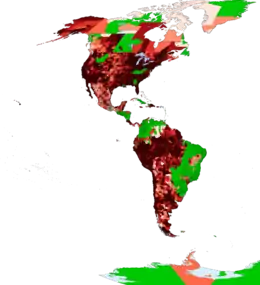 | |
| Disease | COVID-19 |
| Virus strain | SARS-CoV-2 |
| Location | South America |
| First outbreak | Wuhan, China |
| Index case | São Paulo, Brazil |
| Arrival date | 26 February 2020 (11 months and 2 weeks ago) |
| Confirmed cases | 13,254,893[1] |
| Recovered | 11,875,653[1] |
Deaths | 363,634[1] |
Territories | 14[1] |
| Part of a series on the |
| COVID-19 pandemic |
|---|
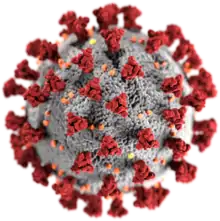 |
|
|
|
On 13 May, it was reported that Latin America and the Caribbean had reported over 400,000 cases of infection with 23,091 deaths. On 22 May, citing especially the rapid increase of infections in Brazil, the World Health Organization declared South America the epicentre of the pandemic.[4][5]
As of 20 September, South America has about 7.5 million confirmed cases and 238,000 deaths. Due to a dearth of testing and medical facilities, it is believed that the outbreak is far larger than the official numbers show.[6] With more than 4.2 million confirmed cases and almost 130,000 deaths as of 10 September, Brazil is the second worst-affected country in the world after the United States.
Pandemic by country and territory
| Countries and territories | Cases | Deaths | Recoveries[lower-alpha 1] | Population (in millions) |
Ref |
|---|---|---|---|---|---|
| 7,700,578 | 195,411 | 6,855,372 | 211.5 | [8][9] | |
| 1,654,880 | 43,495 | 1,520,548 | 49.4 | [10] | |
| 1,629,565 | 43,319 | 1,426,676 | 44.9 | [11] | |
| 1,015,137 | 37,680 | 951,318 | 32.1 | [12][13] | |
| 612,564 | 16,660 | 579,203 | 19.1 | [14] | |
| 213,378 | 14,051 | 184,507 | 17.5 | [15][16] | |
| 160,985 | 9,175 | 132,510 | 11.5 | [7][17] | |
| 113,884 | 1,030 | 107,901 | 32.2 | [7][18] | |
| 108,349 | 2,262 | 81,977 | 7.2 | [19] | |
| 19,753 | 193 | 13,990 | 3.5 | [7][20] | |
| 13,166 | 71 | 9,995 | 0.3 | [7] | |
| 6,348 | 164 | 5,868 | 0.8 | [7] | |
| 6,277 | 123 | 5,771 | 0.6 | [21] | |
| 29 | 0 | 17 | 0.003 | [7][22] | |
| Total | 13,254,893 | 363,634 | 11,875,653 | 430 | [7] |
South America and Latin America
On 26 June 2020, the number of confirmed COVID-19 cases in South America surpassed 2 million while the United States had about 2.4 million. However, a month later on 26 July 2020, if Mexico and key areas in Central America and the Caribbean are included, then the total in Latin America (4.27 million) has surpassed the total in the United States (4.25 million).
| Countries and territories | Cases | Deaths | Recoveries[lower-alpha 2] | Population (in millions) |
Ref |
|---|---|---|---|---|---|
| South America | 13,254,893 | 363,634 | 11,875,653 | 430 | [7] |
| 1,437,185 | 126,507 | 1,083,768 | 128 | [7] | |
| 249,733 | 4,064 | 197,928 | 4 | [7] | |
| 172,218 | 2,416 | 131,543 | 11 | [7] | |
| 169,321 | 2,185 | 131,923 | 5 | [7] | |
| 138,236 | 4,820 | 126,606 | 17 | [7] | |
| 122,974 | 3,160 | 56,936 | 10 | [7] | |
| Total | 15,544,560 | 506,786 | 13,604,357 | 605 | [7] |
Comparison of confirmed COVID-19 cases in the US, South America, and selected regions in Latin America (figures in millions are rounded-off):
| Date | USA | South America | Latin America |
|---|---|---|---|
| Jul 30 | 4.6 | 3.9 | 4.7 |
| Aug 10 | 5.1 | 4.8 | 5.5 |
| Aug 20 | 5.6 | 5.5 | 6.4[23] |
| Aug 30 | 6.0 | 6.2 | 7.2 |
| Sep 10 | 6.5 | 6.9 | 8.0 |
| Sep 20 | 6.9 | 7.5 | 8.7 |
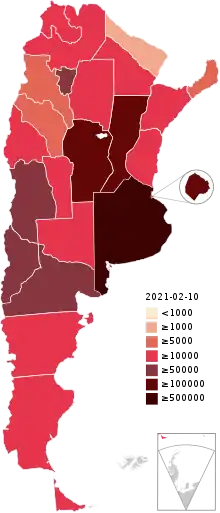
Argentina
The COVID-19 pandemic in Argentina is part of the worldwide pandemic of coronavirus disease 2019 (COVID-19) caused by severe acute respiratory syndrome coronavirus 2 (SARS-CoV-2). On 3 March 2020, the virus was confirmed to have spread to Argentina.[24][25][26][27] As of 8 February 2021 a total of 1,985,484 people were confirmed to have been infected, and 49,398 people were known to have died because of the virus.[28] On 7 March 2020, the Ministry of Health confirmed the country's first documented death, a 64-year-old man who had travelled to Paris, France, who also had other health conditions; the case was only confirmed as positive after the patient's demise.[29]
On 19 March 2020 a nation-wide lockdown was established in Argentina.[30][31] The government later extended the lockdown to mid April,[32] then 26 April;[33] and on 25 April, President Alberto Fernández announced that the lockdown would be extended in major cities until 10 May.[34] The lockdown was lifted throughout all the country, excepting the Greater Buenos Aires urban area (where 31.9% of the country's population live),[35] on 10 May, with Greater Buenos Aires locked down until 24 May,[36] later extended to 7 June,[37] and then 28 June, after a big jump in the number of new cases in this area.[38] On 26 June, Fernández announced that the restrictions on movement in this area that were previously eased would be tightened again until 17 July due to a large spike in cases on the previous days.[39] Finally, on 17 July, the lockdown was due to be gradually loosened in several stages to lead to the return to normality,[40] although restrictions were extended several times until 8 November 2020.[41]
Responses to the outbreak have included restrictions on commerce and movement, closure of borders, and the closure of schools and educational institutions.[42] Clusters of infections and deaths have occurred in nursing homes, prisons and other detention centers, and urban areas.[43][44] The number of tests increased over time, although there were some concerns as there was less testing than in other countries of the region such as Chile and Peru.[45] Even so, the government's responses to the pandemic were among the best received by the population in the region during the early stages of the pandemic.[46]Bolivia
The COVID-19 pandemic in Bolivia is part of the worldwide pandemic of coronavirus disease 2019 (COVID-19) caused by severe acute respiratory syndrome coronavirus 2 (SARS-CoV-2). The virus was confirmed to have spread to Bolivia on 10 March 2020, when its first two cases were confirmed in the departments of Oruro and Santa Cruz.[47][48]
On 12 March, Bolivia suspended all public school sessions until 31 March, as well as all commercial flights to and from Europe indefinitely. They also prohibited large-scale public gatherings of more than 1,000 people.[49]Brazil
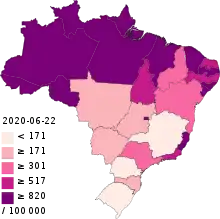
The COVID-19 pandemic in Brazil is part of the ongoing pandemic of coronavirus disease 2019 (COVID-19) caused by severe acute respiratory syndrome coronavirus 2 (SARS-CoV-2). The virus was confirmed to have spread to Brazil on 25 February 2020,[50] when a man from São Paulo tested positive for the virus. The disease had spread to every state in Brazil by 21 March. On 19 June 2020, the country reported its 1 millionth case; at this time, there had been nearly 49,000 reported deaths.[51][52] As of September 2020, Brazil has the third-highest number of confirmed COVID-19 cases in the world behind India and the United States. On 17 July 2020, the country reported its 2 millionth case. On 8 August 2020, the country reported its 3 millionth case with deaths exceeding up to 100,000. By mid January 2021, confirmed cases exceeded 8 million, with deaths exceeding 200,000. Brazil is one of the worst affected countries in the world.
The pandemic has triggered a variety of responses from federal, state and local governments, having an impact on politics, education, the environment,[53] and the economy. On 27 March Brazil announced a temporary ban on foreign air travelers[54] and most state governors have imposed quarantines to prevent the spread of the virus.[55]Chile
The COVID-19 pandemic in Chile is part of the worldwide pandemic of coronavirus disease 2019 (COVID-19) caused by severe acute respiratory syndrome coronavirus 2 (SARS-CoV-2). The virus was confirmed to have reached Chile in March 2020.[56] While initial cases had been imported from Southeast Asia and Europe, they have since expanded into a sizeable quantity of untraceable infections, placing the country within phase 4 of the pandemic as defined by the World Health Organization, and surpassing one thousand confirmed cases on 25 March 2020.
The cases are concentrated in the Santiago metropolitan area, with outbreaks in other regions in the country. No national lockdown was established in Chile, unlike in neighbouring Argentina and Peru, although a night curfew was implemented throughout the country. Quarantines were established locally in different cities and neighborhoods. However, in May 2020, the whole city of Santiago was put under mandatory quarantine due to an increase of cases and similar situations were extended to most of the largest cities in Chile.
Considering its population, Chile has one of the worst outbreaks in the world,[57] with more than 38,000 cases and 1,200 deaths per million inhabitants.[58] Initially, the number of fatalities reported was lower than other countries in South America, even with less cases. However, in May 2020, the number of cases and deaths increased rapidly, while several sources reported additional numbers of excess deaths which were not counted.[59][60] By June 2020, the government confirmed thousands of additional deaths due to COVID-19, including suspected cases where PCR tests were not available.[61] The pandemic reached its apparent peak on 13 June with 195 daily confirmed deaths and nearly 7,000 positive cases.[58] By July 2020, the number of deceased surpassed 10,000 people and Chile became the sixth largest number of cases in the world.[62][63] In the following weeks, the number of daily cases and deaths started to decrease slowly, although some local outbreaks appeared.
The impact of the pandemic has been great in the South American country. In March 2020, when the first cases of COVID-19 were reported, the country was still facing protests and riots[lower-alpha 3] that had begun in October 2019, and the pandemic affected the scheduled 2020 Chilean national plebiscite, which was rescheduled. Partial lockdowns and quarantines were established in the first months, hitting the economy of the country. By April 2020, unemployment had reached 9%, a record-high level in the past 10 years,[65] while the economy had shrunk by 14.1% the first months of the year,.[66] A wave of protests sparked in late May, mainly in Santiago, due to food shortages in certain sectors of the population.[67]Colombia
Ecuador
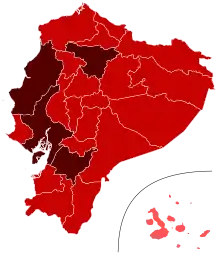
On 29 February, the Minister of Health in Ecuador, Catalina Andramuño, confirmed the first case of the virus in the country.[72] The patient, a woman in her 70s, Ecuadorian citizen who resides in Spain, had arrived to Guayaquil on 14 February.[72]
On 1 March, Andramuño announced that five new cases of coronavirus have been confirmed in Ecuador.[73]
As of 31 March, there have been 2240 confirmed cases, plus 75 deaths linked to COVID-19. The Health Ministry also reported 61 deaths probably related to COVID-19.[74]
Ecuador was described in April as emerging as the "epicentre" of the pandemic in Latin America.[3] The Guayas Province was particularly strongly affected, with thousand of excess deaths reported compared to the figure for a normal period.[75] It was reported on 17 April that 10,939 people had died in six weeks since the start of March in the Guayas Province, compared to a normal figure of 3,000 for the province.[76]
Falkland Islands
On 3 April 2020, the British Overseas Territory of the Falkland Islands confirmed its first case on 3 April 2020.[77] Furthermore, as a precaution, the islands' government has closed all schools and nurseries until 4 May.[78] As of 30 April, all 13 cases have recovered.[79]
French Guiana
On 4 March 2020, the first 5 cases were found the French overseas department and region of French Guiana,[80] and the first death was announced on 20 April 2020.[81]
Guyana

Paraguay
On 7 March the first confirmed case in Paraguay was announced, a 32-year-old Paraguayan who arrived from Ecuador.[85]
On 10 March, Paraguay suspended public school sessions and large-scale public events for 15 days due to the coronavirus.[86]
On 13 March, Paraguay suspended flights coming from Europe.[87]
Peru
The COVID-19 pandemic in Peru is part of the worldwide pandemic of coronavirus disease 2019 (COVID-19) caused by severe acute respiratory syndrome coronavirus 2 (SARS-CoV-2). The virus was reported to have spread to Peru on 6 March 2020, when a 25-year-old man who had travelled to Spain, France, and the Czech Republic tested positive.[88] On 15 March 2020, President Martín Vizcarra announced a country-wide lockdown, closing borders, restricting domestic travel, and forbidding nonessential business operations, excluding health facilities, food vendors, pharmacies, and financial institutions.
Peru, with a total population of 32 million,[89] has a total of 1,002 intensive care unit (ICU) beds available as of May 2020,[90] and was working on expanding its nationwide ventilator stock from 40 to a desired 540 machines. Engineering and production are supplied by the Peruvian Armed Forces.[91] As of June 2020, oxygen was in short supply.[92]Suriname
On 13 March 2020, Vice President Ashwin Adhin announced the first confirmed case in the country.[93]
On 3 April, the first death was announced.[94]
On 3 May, all remaining COVID-19 cases recovered.[95]
On 18 May, an eleventh case was identified.[96]
On 11 August, President Santokhi announced a series of measures requiring the use of face masks, reducing operating practices of restaurants, and prohibiting groups of 5 or people from gathering except for work, education, religious gatherings and funerals. A national curfew would be in place from 21:00 to 5:00 everyday until 23 August.[97]
Uruguay
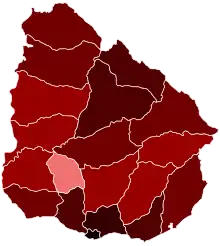
The COVID-19 pandemic in Uruguay is part of the worldwide pandemic of coronavirus disease 2019 (COVID-19) caused by severe acute respiratory syndrome coronavirus 2 (SARS-CoV-2). The first cases in Uruguay were reported on 13 March 2020 by the Ministry of Public Health.[98] The early cases were imported from Italy and Spain, with some local transmissions.[99]
The majority of early cases were traced to a wedding with 500 people in Montevideo, attended by a Uruguayan fashion designer who returned from Spain and later tested positive.[100][101] Various containment measures were introduced in mid-March, and major restrictions on movement followed in late March. Uruguay is one of the few countries in Latin American to have been able to avoid large outbreaks for a considerable amount of time due to extensive testing. The country had one of the lowest numbers of active cases per population in South America up until December when the public health authorities announced that large outbreaks had led to community transmission in Montevideo.[102] On January 23, 2021, President Lacalle Pou announced at a press conference that the government purchased doses of COVID-19 vaccines from Pfizer and Sinovac, while negotiating with a third one.[103]Venezuela
On 13 March, Vice President Delcy Rodríguez announced the first two confirmed cases in the country.[104]
On 14 March, Communication Minister Jorge Rodríguez informed that eight new cases were detected in the country.[105]
On 26 March, the first death was reported.[106]
Diosdado Cabello, vice-president of the United Socialist Party of Venezuela and president of the pro-government Constituent National Assembly announced he tested positive for COVID-19 on 9 July.[107]
Tareck El Aissami, the Minister of Petroleum and Omar Prieto, the Governor of Zulia also tested positive on 10 July.[108]
A member of the 2017 National Constituent Assembly and the Governor of the Capital District, Darío Vivas tested positive for COVID-19 on 19 July.[109]
Venezuela Minister of Communication and Information Jorge Rodríguez tested positive for COVID-19 on 13 August.[110] On the same day, Darío Vivas died of COVID-19 at the age of 70.[109]
Venezuela is particularly vulnerable to the wider effects of the pandemic because of its ongoing socioeconomic and political crisis causing massive shortages of food staples and basic necessities, including medical supplies. The mass emigration of Venezuelan doctors has also caused chronic staff shortages in hospitals.[111]
Prevention in other countries and territories
South Georgia & the South Sandwich Islands
This remote territory is uninhabited, save for small communities of scientists; the territory is also occasionally visited by small groups of tourists.[112] On 17 March tourist facilities in Grytviken were closed as a precaution,[113] with various other measures being implemented to protect workers on the islands.[114] South Georgia is open for visitors with a permit and is still virus free as of 22 April.[115]
Notes
- Reported recoveries. May not correspond to actual current figures and not all recoveries may be reported. Total recoveries may not necessarily add up due to the frequency of values updating for each location.
- Reported recoveries. May not correspond to actual current figures and not all recoveries may be reported. Total recoveries may not necessarily add up due to the frequency of values updating for each location.
- As a result of the COVID-19 pandemic, many of those who suffered eye injuries during the 2019–2020 protests have not been able to continue their treatments.[64] In the cases where injured have gone to hospital for treatment and supervision some have had to share rooms with COVID-19 patients.[64]
References
- "Coronavirus update (live)". 20 March 2020.
- Horwitz L, Nagovitch P, Sonnel HK, Zissis C. "Where Is the Coronavirus in Latin America?". AS/COA. Archived from the original on 22 March 2020. Retrieved 22 March 2020.
- "Uncollected bodies lie for days in the streets of Ecuador the emerging epicentre of the coronavirus in Latin America". Stuff/Fairfax. 4 April 2020.
- "WHO declares that South America is the new coronavirus epicenter". The Washington Post. Retrieved 23 May 2020.
- Ward, Alex. "How South America became a coronavirus epicenter". Vox. Retrieved 28 May 2020.
- "How Brazil went from carnival floats to mass graves. Photos show what it's like in the world's latest coronavirus hotspot". Business Insider. Retrieved 28 May 2020.
- "Coronavirus COVID-19 Global Cases by the Center for Systems Science and Engineering (CSSE) at Johns Hopkins University (JHU)". arcgis.com. Johns Hopkins University. 19 March 2020. Retrieved 19 May 2020.
- "Painel Coronavírus" (in Portuguese). Ministry of Health (Brazil). Retrieved 19 May 2020.
- "Casos de coronavírus e número de mortes no Brasil em 10 de maio". G1 (in Portuguese). 10 May 2020. Retrieved 10 May 2020.
- "Coronavirus en Colombia". Instituto Nacional de Salud. Retrieved 20 March 2020.
- "Información epidemiológica". Argentina.gob.ar. Gobierno de Argentina. Retrieved 11 April 2020.
- Ministry of Health (Peru). "Sala Situactional COVID-19 Perú" (in Spanish). Retrieved 3 May 2020.
- "Minsa: Casos confirmados por coronavirus COVID-19 ascienden a 45 928 en el Perú (Comunicado N° 86)" (in Spanish). Plataforma digital única del Estado Peruano. 3 May 2020. Retrieved 3 May 2020.
- "Casos confirmados en Chile COVID-19". Ministerio de Salud. Retrieved 1 May 2020.
- "Actualización de casos de coronavirus en Ecuador". Ministerio de Salud Pública. Retrieved 1 May 2020.
- "COVID-19 Ecuador" (in Spanish). Retrieved 24 April 2020.
- "Datos Oficiales". Bolivia Segura (in Spanish). Retrieved 17 May 2020.
- "Venezuela registra un fallecido y 156 casos de coronavirus en las últimas 24 horas #2Jun". Efecto Cocuyo (in Spanish). 2 June 2020. Retrieved 2 June 2020.
- "CONTADOR COVID-19 PY". Ministerio de Salud Publica y Bienestar Social. Retrieved 23 April 2020.
- "Visualizador de casos coronavirus COVID-19 en Uruguay". Sistema Nacional de Emergencias (in Spanish). Retrieved 17 May 2020.
- "COVID SURINAME". Retrieved 18 May 2020.
- "COVID-19 Update – 30 April 2020". Falkland Island Government. Retrieved 1 May 2020.
- Pandemic threatens to undo a decade of Latin American progress
- "Confirmaron el primer caso de coronavirus en la Argentina: es un hombre que viajó a Italia". Clarín (in Spanish). 3 March 2020. Archived from the original on 3 March 2020. Retrieved 3 March 2020.
- "Confirmaron el primer caso de coronavirus en la Argentina". Infobae (in Spanish). 3 March 2020. Retrieved 3 March 2020.
- Quinn, Sarah Marsh (now); Ben; Campbell, Lucy; Rourke (earlier), Alison; Tondo, Lorenzo; Marsh, Sarah; Mason, Rowena; Campbell, Lucy (3 March 2020). "Coronavirus: Iran to mobilise 300,000 soldiers and volunteers as 23 MPs infected – latest news". The Guardian. ISSN 0261-3077. Retrieved 3 March 2020 – via www.theguardian.com.
- "Se confirmó el segundo caso de coronavirus en Argentina: es un hombre de 23 años que vino de Italia". Infobae (in Spanish). Retrieved 5 March 2020.
- "Informes diarios" [Daily reports] (in Spanish). Ministry of Health.
- "Primera muerte por coronavirus en Argentina: era un hombre que había viajado a Francia y estaba internado en el Argerich". Infobae (in Spanish). 7 March 2020. Archived from the original on 7 March 2020. Retrieved 20 March 2020.
- "Argentina announces mandatory quarantine to curb coronavirus". Reuters. 19 March 2020. Retrieved 20 March 2020.
- Do Rosario, Jorgelina; Gillespie, Patrick (20 March 2020). "Argentina Orders 'Exceptional' Lockdown in Bid to Stem Virus". Bloomberg News.
- "Argentina extends coronavirus quarantine until mid April". Reuters. 29 March 2020. Retrieved 30 March 2020.
- "Argentina's Fernandez extends coronavirus lockdown through April 26". Reuters. 10 April 2020. Retrieved 10 April 2020.
- "Argentina extends coronavirus quarantine until May 10". Reuters. 25 April 2020.
- "Población | Instituto Geográfico Nacional" [Population | National Geographic Institute]. National Geographic Institute (in Spanish). Ministry of Defense (Argentina). Retrieved 8 September 2020.
- "Argentina extends quarantine for capital Buenos Aires, relaxes elsewhere - President". Reuters. 9 May 2020. Retrieved 9 May 2020.
- Raszewski, Eliana; Garrison, Cassandra (23 May 2020). "Buenos Aires lockdown extended until June 7 after rise in coronavirus cases". Reuters. Retrieved 23 May 2020.
- "Argentina extends lockdown in Buenos Aires until June 28". Reuters. 4 June 2020.
- Jourdan, Adam; Misculin, Nicolás; Raszewski, Eliana; Heath, Maximilian (26 June 2020). "Argentina tightens Buenos Aires lockdown as coronavirus cases surge". Reuters. Archived from the original on 26 June 2020.
- Misculin, Nicolás (17 July 2020). "Argentina to ease Buenos Aires restrictions after nearly four months of tight lockdown". Reuters. Retrieved 17 July 2020.
- "AMBA moves from 'isolation' to 'distancing'; Fernández talks up vaccine hopes". Buenos Aires Times (Perfil). 6 November 2020.
- "Argentina to close borders for non-residents to combat coronavirus". Reuters. 15 March 2020. Retrieved 18 April 2020.
- "Confirmaron al menos cinco muertes por coronavirus y otros 19 casos positivos en un geriátrico de San Martín". Infobae (in Spanish). 12 May 2020.
- "Coronavirus en Argentina: dio positivo un penitenciario en la cárcel de Devoto y otros seis agentes fueron aislados". Clarín (in Spanish). 23 April 2020.
- Arambillet, Delfina; Ruiz, Iván (4 May 2020). "Coronavirus: la Argentina es uno de los países que menos testeos hacen en la región". La Nación (in Spanish). Retrieved 4 May 2020.
- Misculin, Nicolás (3 July 2020). "Uruguay, Paraguay, Argentina get best marks in Latin America for pandemic response - poll". Reuters. Retrieved 3 July 2020.
- @MinSaludBolivia (10 March 2020). "#ULTIMO" (Tweet) – via Twitter.
- "Confirman los dos primeros casos de coronavirus en Bolivia". Los Tiempos (in Spanish). 10 March 2020. Retrieved 11 March 2020.
- "Gobierno suspende clases hasta el 31 de marzo y todos los vuelos europeos desde el sábado". Los Tiempos (in Spanish). 12 March 2020. Retrieved 12 March 2020.
- "Brasil confirma primeiro caso da doença". Ministerio da Saude. 26 February 2020. Archived from the original on 6 March 2020. Retrieved 4 March 2020.
- Charner, Flora (19 June 2020). "Brazil tops 1 million Covid-19 cases. It may pass the US next, becoming the worst-hit country on the planet". CNN. Retrieved 19 June 2020.
- "Painel Coronavírus". Retrieved 12 June 2020.
- "Deforestation of Amazon rainforest accelerates amid COVID-19 pandemic". ABC News. 6 May 2020.
- Pedro Fonseca; Jamie McGeever (28 March 2020). "Coronavirus: Brazil bans foreign air travelers". The Mercury News. Retrieved 13 April 2020.
- "Brazil reports more than 1,000 coronavirus deaths". BBC News. 11 April 2020. Retrieved 13 April 2020.
- "Chile records first confirmed case of coronavirus: health ministry". Archived from the original on 5 March 2020. Retrieved 3 March 2020.
- Fuentes, Valentina; Sanders, Philip (16 June 2020). "Once a Covid Role Model, Chile Now Among the World's Worst". Bloomberg. Retrieved 29 June 2020.
- "Cifras Oficiales COVID-19". Ministerio de Salud (in Spanish) (February 2021). Government of Chile. 9 February 2021. Retrieved 9 February 2021.
- Wu, Jin; McCann, Allison; Katz, Josh; Peltier, Elian. "87,000 Missing Deaths: Tracking the True Toll of the Coronavirus Outbreak". The New York Times. Retrieved 31 May 2020.
- "Coronavirus tracked: the latest figures as countries fight to contain the pandemic". Financial Times. Retrieved 31 May 2020.
Death rates have climbed far above historical averages in may countries that have faced Covid-19 outbreaks. Chile: 1,600 (+24%) by May 20.
- "Gobierno informa 3.069 fallecidos sospechosos de Covid-19". Cooperativa.cl (in Spanish). 20 June 2020. Retrieved 20 June 2020.
- "Informe Epidemiológico Nº31 - Enfermedad por SARS-CoV-2 (COVID-19)" (PDF). Department of Statistics and Health Information - Ministry of Health of Chile (in Spanish). 5 July 2020. Retrieved 5 July 2020.
- Díaz, Nicolás (3 July 2020). "Chile supera a Reino Unido y se convierte en el sexto país con más casos de Covid-19 en el mundo". BioBioChile. Retrieved 30 September 2020.
- "Heridos oculares del estallido chileno, "abandonados" en medio de la pandemia". El Diario (in Spanish). 6 June 2020. Retrieved 19 June 2020.
- "Directo hacia los dígitos: desempleo aumentó al 9% en el trimestre febrero-abril en todo Chile". El Mostrador. 29 May 2020. Retrieved 31 May 2020.
- Carvajal G., Claudia (1 June 2020). "Oscuro panorama: Imacec de abril cae en 14,1 por ciento y la economía chilena se desploma". Radio Universidad de Chile. Retrieved 1 June 2020.
- Ramos, Natalia; Sherwood, Dave (18 May 2020). "Chile's poor clash with police amid concerns over food shortages in outskirts of Santiago". Reuters. Retrieved 19 May 2020.
- "Twitter". Archived from the original on 7 March 2020. Retrieved 6 March 2020 – via Twitter.
- "Colombia confirma su primer caso de COVID-19". minsalud.gov.co. Archived from the original on 9 March 2020. Retrieved 6 March 2020.
- "Coronavirus: Which countries have travel bans?". CNN. 17 March 2020. Retrieved 17 March 2020.
- "COLOMBIA TRAVEL RESTRICTIONS". Travelbans. Retrieved 9 October 2020.
- "Ministra de Salud confirma primer caso de #coronavirus en Ecuador. La paciente llegó desde España el pasado 14 de febrero". Archived from the original on 2 March 2020. Retrieved 29 February 2020.
- @elcomerciocom (1 March 2020). "#ATENCIÓN La ministra de Salud, Catalina Andramuño, informa cinco nuevos casos positivos de #COVID19 en Ecuador. Los afectados son del círculo primario familiar de la paciente. Y se encuentran con sintomatología leve y se mantiene la vigilancia permanente" (Tweet) (in Spanish) – via Twitter.
- Ministerio de Salud Pública, Gaceta epidemiológica 030
- "Coronavirus: Ecuador sees massive surge in deaths in April". BBC. 17 April 2020.
- Collyns D (17 April 2020). "Ecuador's death rate soars as fears grow over scale of coronavirus crisis". The Guardian.
- FalklandsinUK (3 April 2020). "A case of coronavirus #COVID19 has been confirmed in the #FalklandIslands. An inpatient in the #Falklands hospital who is in isolation has tested positive for the virus. The patient was admitted from the Mount Pleasant Complex on 31 March with a range of COVID19 like symptoms.pic.twitter.com/KNE5nRnCYf". @FalklandsinUK. Retrieved 3 April 2020.
- "Falkland Islands: New stage in Government COVID-19 response". Merco Press. 26 March 2020. Retrieved 26 March 2020.
- "COVID-19 Public Update – 30 April 2020". Falkland Islands Government. Retrieved 1 May 2020.
- "Five coronavirus cases confirmed in French Guiana March 4, 2020". Antigua Observer. 4 March 2020. Retrieved 5 March 2020.
- "Un premier mort du Covid-19 en Guyane". France Guyane (in French). Retrieved 20 April 2020.
- "Breaking News! Guyana records first coronavirus-related death". Kaieteur News. 11 March 2020. Retrieved 12 March 2020.
- "Guyana confirms first case of coronavirus in woman who returned from U.S." Reuters. 12 March 2020. Retrieved 12 March 2020.
- "Breaking News! Guyana records first coronavirus-related death". Kaieteur News. 11 March 2020. Retrieved 12 March 2020.
- "Paraguay reports first coronavirus case". Deccan Herald. 8 March 2020.
- "Paraguay Suspends Public Schools for 15 Days Due to Coronavirus". The New York Times. Reuters. 10 March 2020. Retrieved 10 March 2020.
- "Paraguay Suspends Flights from Spain Due to Coronavirus". ABC Color. ABC. 13 March 2020. Retrieved 13 March 2020.
- "Peru records first confirmed case of coronavirus, President Vizcarra says". Reuters. 6 March 2020. Retrieved 6 March 2020.
- "Peru Population (2020) – Worldometer". worldometers.info. Retrieved 5 April 2020.
- "Perú tendrá 4.486 nuevas camas de hospitalización y 232 de UCI para atender la pandemia" (in Spanish). 14 May 2020. Retrieved 17 June 2020.
- World, Republic. "Peru manufactures respirators for virus patients". Republic World. Retrieved 5 April 2020.
- Guy, Jack; Rebaza, Claudia (5 June 2020). "Peruvians cry out for oxygen as coronavirus takes its toll". CNN. Retrieved 5 June 2020.
- "Suriname confirms first coronavirus case, authorities will close borders". Reuters. 13 March 2020. Retrieved 13 March 2020 – via www.reuters.com.
- "Suriname confirms first death". COVID SURINAME. Retrieved 4 April 2020.
- "Suriname free of COVID-19 positives border situation requires alertness (in Dutch)". Covid Suriname. Retrieved 3 May 2020.
- "Again a COVID-19 infected person in Suriname". Covid-19 Suriname. Retrieved 18 May 2020.
- McLeod, Sheri-Kae (11 August 2020). "Suriname Government Extends National Curfew to Curb COVID-19 Spike". Caribbean News. Retrieved 18 August 2020.
- "A brand-new challenge" (in Spanish). El Observador. 15 March 2020.
- "Confirmaron primeros 4 casos de coronavirus en Uruguay; todos habían regresado de Italia" (in Spanish). EL PAIS. 13 March 2020.
- "Half of Uruguay's coronavirus cases traced to a single guest at a society party". The Guardian. Retrieved 30 March 2020.
- "Half of Uruguay's COVID-19 cases can be traced to one fashion designer". Fastcompany.com. Retrieved 23 May 2020.
- "El GACH proyecta a Uruguay en "zona roja" el 27 de diciembre si se mantiene la tendencia actual". El Observador. Retrieved 6 January 2021.
- "Pfizer y Sinovac: las primeras vacunas elegidas por el gobierno". El Observador. Retrieved 27 January 2021.
- "Régimen de Maduro confirma dos primeros casos de coronavirus". NTN24.com (in Spanish). 13 March 2020. Retrieved 13 March 2020.
- Torrealba D (14 March 2020). "Suben a 10 los casos por coronavirus en Venezuela". El Pitazo (in Spanish). Retrieved 15 March 2020.
- "Venezuela confirms first coronavirus death: official". Reuters. 26 March 2020. Retrieved 27 March 2020.
- "Venezuela socialist party boss announces he has COVID-19". AP NEWS. 9 July 2020. Retrieved 10 July 2020.
- "Venezuela oil minister El Aissami tests positive for COVID-19". Reuters. 10 July 2020. Retrieved 10 July 2020.
- "Governor of Venezuela's capital district, key Maduro ally, dies of COVID-19". Reuters. 13 August 2020. Retrieved 15 August 2020.
- "Close adviser to Venezuela's president has coronavirus". Associated Press. 13 August 2020. Retrieved 13 August 2020.
- "Venezuela Conducts 'Tens' of Virus Tests and Bans Europe Flights". Bloomberg. 12 March 2020. Retrieved 13 March 2020.
- "About SGSSI – Government of South Georgia & the South Sandwich Islands". Gov.gs. Retrieved 30 March 2020.
- "Precautionary Measures at Grytviken – Government of South Georgia & the South Sandwich Islands". Gov.gs. Retrieved 30 March 2020.
- "GSGSSI COVID-19 Update – Government of South Georgia & the South Sandwich Islands". Gov.gs. Retrieved 30 March 2020.
- "South Georgia remains free of COVID-19; Grytviken closed to visitors until next August". Merco Press. Retrieved 25 April 2020.
External links
| Wikimedia Commons has media related to COVID-19 pandemic in South America. |
- Corona MAP – Daily updated interactive free map of the whole world.
- Coronavirus Timeline Map – Maps the timeline of the Coronavirus infections, deaths and recoveries.
- Epidemic data for COVID-19 – Maps total cases of coronavirus in the world, China and the United States, along with patient data.
- Coronavirus COVID-19 Global Cases and historical data by Johns Hopkins University
- CoronaMapper – Map with several updated statistics
- Coronavirus Updates – Daily updated totals of South America